 The Genera
The Genera
Nymphoides and Villarsia
By David Curtright, Escondido, California
Click images to enlarge
The genera Nymphoides and Villarsia are among
the more interesting and decorative groups of plants in the aquatic
gardening hobby. Their interesting leaves and lovely flowers
make a pleasant addition to any water garden and their size and
habits make them suitable for water gardens of all sizes.
Surprisingly perhaps, to the neophyte, these plants are not
related to water lilies, as one might infer from their general
appearance and from the name Nymphoides. The name Nymphoides
means similar to, or in the form of, a Nymphaea (water
lily), but implies no direct relationship to that genus. Actually,
they are in the family Gentianaceae, which puts them in
league with Centaurium, which has representatives in California
and other western states; Chironia, native to South Africa
and with one aquatic species, C. palustris; Eustoma,
or Prairie Gentian; Fauria crista-galli (Deer Cabbage),
a moisture loving favorite in the north; Frasera, 15 species
of moisture loving plants, mostly native to the Pacific Northwest;
Gentiana, a huge genus of familiar plants; and many others,
in particular Menyanthes, a favorite in our hobby. Some
authors put them into the family Menyanthaceae because
of certain structural differences. Early taxonomists used the
generic name, Limnanthemum, instead of Nymphoides.
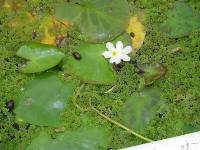
N. cristata

N. indica |
The genera in question, though, are very different from
one another in their habits, but quite similar in their structures.
In the case of Nymphoides, the basic structure is a rosette
of leaves, held on thin petioles which rise from a stoloniferous
base. The leaves are held on the surface of the water much like
those of water lilies, hence the name Nymphoides. Leaves
may be elliptical, chordate, or round. They may be entire (smooth-edged)
or they might exhibit varying degrees of scalloping. In all species,
reproduction is by viviparous leaves, by seeds, or by runners.
In the case of the viviparous leaves, the new plantlets produce
plantlets of their own and so on until a dense colony of plants
is formed on the surface of the water, often to the point of
covering the surface completely. These species also produce numerous
white flowers from the same buds under the leaves. This group
includes N. indica, N. cristata, N. spongifolia, and others. |
|
Other species of Nymphoides reproduce by runners, which
can snake around a pond forever, producing plants at intervals.
These species produce flowers from the same nodes that produce
the new plants (N. peltata) or at the end of special axilary
stems, or peduncles (N. crenata). Flowers in this group
are yellow or yellow-orange. |
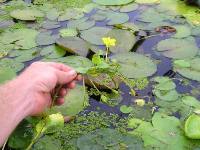
N. peltata |
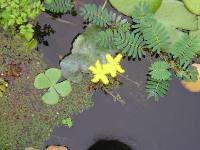
N. crenata |
Nymphoides species may be planted along the margins of
ponds or streams in about 12" of water, or they may be planted
in a pot in open water and allowed to form colonies at the surface.
This may be done in up to 20" of water. Other species, on
the other hand, prefer to send their runners to the surface.
Here they produce a young plant and several flowers, and a continuation
of the runner, which can attain several feet of length. |
|
In all of the Nymphoides species, flowers are produced
from mid spring through the summer, and frequently into the fall.
In some species the petals are fringed with fine hairs along
their margins. These include N. crenata and N. indica.
Most of the rest have smooth or slightly ruffled petal edges.
N. cristata has a small raised area running down the length
of the petal, hence the name, cristata, which means 'crested'.
I have only seen seeds produced by one species, N. peltata,
or the so-called "Water Fringe", a.k.a.., "Floating
Heart". The seeds look for all the world like young ticks.
They are light brown in color, about 3/16" in diameter,
are flattened, and have little hairs protruding from their margins,
making them look almost exactly like a tick in need of a meal.
They germinate in mud or shallow water after a rest period of
some length. They develop quickly into stout, little upright
plants just waiting for a flood. |
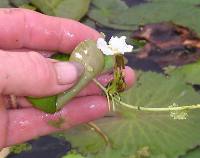
N. cristata |

N. indica |

N. peltata |
Villarsia, on the other hand, is somewhat different.
In this case, leaves are chordate to round, and are held on erect
petioles. They are more attuned to growing above the water line,
as opposed to holding their leaves right on the water. There
are 16 species and they are all aquatic or semi-aquatic.
Villarsia species are best used at the margins of ponds
or waterfall weirs and stream sides. V. parnassifolia
will grow with its root crown well exposed to the air, while
V. reniformis will tolerate water up to 8 or 10 inches
deep, although it holds its leaves and flowers well above the
water. V. violacea will grow in up to 1.5"of water,
but is quite at home growing on exposed mud. All of these species
hold their leaves nearly erect and produce flowers in clusters
of 3 to 12 at the end of long, axillary peduncles.
Unfortunately, Villarsia species are not as forthcoming
with flowers as are Nymphoides species. They usually bloom
from mid to late spring and then they set seeds and that's it.
As a welcome diversion from this pattern, V. violacea
blooms through the summer in full sun. In my experience, the
flowers of most species are pale to brilliant yellow, about ½",
or slightly larger, in diameter, and are carried in clusters
of 8-15, or so. Each has 5 petals. The flowers of V. violacea
are only about 3/8" in diameter.
|
HOW TO USE THEM:
As mentioned above, these plants have a number of uses. They
can be used in water that is a fraction of an inch deep or water
that is nearly 2 feet deep. As long as they are well lit and
don't get too much competition from algae or other more vigorous
plants, they will do well They prefer rich soil with plenty of
food to do their best. We have used them with great success in
shallow water along pond margins. One use for the smaller species,
especially N. cristata, is as a table-top bowl plant.
Another might be in a whiskey barrel. Nymphoides indica,
the Giant Snowflake, with its large leaves and showy white flowers,
can be planted out with the water lilies.
Maintenance includes removing dead leaves periodically and
in thinning the plants to avoid gross overcrowding. They should
be fed from time to time to keep them performing all summer.
Winter care is a snap with most of these plants, although there
are tender species. N. indica needs to be protected from
winter cold, as does the orange-flowered Nymphoides hydrocharioides.
N. peltata and the N. crenata group will survive
mild winters. |
|
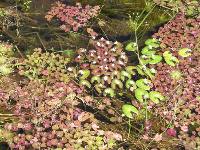
N. spongifolia and another Nymphoides
When Walter Pagels and I were in the Darwin area in
April of 2003, we found N. spongifolia, which I found
to be of great potential to the hobby. It exhibits a horseshoe
shaped leaf that is vividly variegated, somewhat like N. cristata.
As the name would imply, the under side of the leaf is spongy.
It blooms like N. cristata and mature specimens were nothing
short of beautiful. |
This is a group of plants that should enjoy more popularity
than it does. Perhaps the reason that it does not get the attention
that it should is because it is difficult to sell a plant that
produces long runners in a tank full of other plants. They tend
to get tangled rather quickly. Whatever the reason, enthusiasts
should continue to trade these plants because for those who keep
them, the water garden is a far cheerier place than for those
who do not. Their numerous brightly colored flowers open early
in the day and close in the late afternoon, producing an ever-changing
display of flowers and glossy, variegated leaves.
Fecundity
in Nymphoides
|








